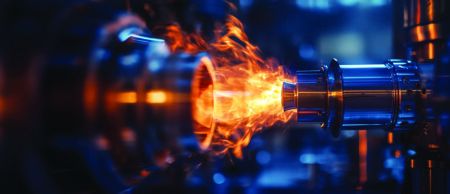The largest wind tunnel in the world. No narrative of the National Full-Scale Aerodynamics Complex (NFAC) at NASA’s Ames Research Center, located about an hour’s drive south of San Francisco, could possibly describe the key feature of this iconic technological installation in the USA, more succinctly.
Yet there is much more to explore, because within its artificial hollows, scientists, engineers and technicians go about their business of testing anything influenced by aerodynamic forces that can be replicated at low speed, sea-level conditions here on Earth.
Parachutes and inflatable heat shields for landing on Mars have seen the inside of the NFAC, as have semi-trailer trucks, or artics – all in the name of improved aerodynamics. But the complex’s principal use has been, and always will be, for advancing aviation technology.
Originally opened in 1944 as a single, closed-circuit wind tunnel with a 40 x 80ft test section, and later expanded in 1987 to include an open-circuit tunnel with an 80 x 120ft test section, the facility has hosted an impressive array of historic aircraft.
An extremely short list includes scale or full-sized models of Northrop’s original flying wing, North American’s F-86 Sabre, Bell’s HU-1 helicopter, the Grumman F-14 Tomcat, the McDonnell Douglas F-18 Hornet and De Havilland’s DASH 8 – not to mention a replica of the Wright Brothers’ 1903 Flyer.
“It’s really a fun place to work,” says Joe Sacco, a NASA manager assigned as the NFAC’s deputy director. Although the complex sits on NASA’s Ames Research Center and is owned by NASA, it is the US Air Force’s Arnold Engineering Development Complex (AEDC) in Tennessee that actually operates the facility, maintains it, and is responsible for any investments and upgrades. It’s an arrangement that has been in place since 2006, three years after NASA was forced to close the NFAC due to budget concerns.
“The US Department of Defense decided it was too critical to future operations and so they made the decision to reopen the facility. It now operates as a geographically separated branch of AEDC,” says Scott Waltermire, an Air Force manager who serves as the NFAC’s director.
The tunnels at work
The two tunnels that make up the NFAC share similarities and are characterized by just as many differences. The 40 x 80ft is a closed-loop system, with possible wind speeds of up to about 300kts depending on the desired dynamic pressure. The open circuit 80 x 120ft tunnel is officially the world’s largest and is so big that it can host a full-scale Boeing 737 inside, and can go up to about 100kts. But because of the way the two tunnels share much of the same space, only one section can be operated at a time.
A system of moveable vanes can be positioned so that air is either drawn through the 80 x 120ft test section and exhausted into the atmosphere, or driven around the closed circuit through the 40 x 80ft test section. A passive air exchange system is used in the 40 x 80ft circuit to keep air temperatures below 125°F.
The current fan drive system is composed of six variable pitch fans, each 40ft in diameter, and arranged in two rows of three. Each fan has 15 laminated wood blades and is powered by a 22,500hp electric motor. The six fans rotate together at 180rpm drawing 106MW of electricity at full power, while moving more than 60 tons of air per second.
Utility support systems that have been used for testing powered vehicles and components include variable frequency electrical power, hydraulic power units, cooling water, and jet fuel systems. Rotor testbeds incorporating electric motors and rotor balance systems are available for testing complete rotor and hub systems independent of the flight vehicle.
“They largely have the same basic capabilities. You take the same basic flow measurements – pressure, temperature, velocity, humidity – in either test section. They are both acoustically treated. The 40 x 80ft has deeper acoustical liners than the 80 x 120ft, so in general it’s a bit better at attenuating sound reflections,” says Charlie Rogers, a US Air Force contractor who serves as a test director.
Both tunnels have video surveillance available during tests and the ability to support optical measurements depending on test requirements. Often a customer will bring in their own non-intrusive optical equipment, which the tunnels can accommodate.
A wide variety of options are available for mounting test subjects in either wind tunnel, with a three-pillar system commonly used in which two of the pillars are fixed in height and the third can be raised, lowered, or yawed to adjust an aircraft’s angle of attack and sideslip to the relative wind.
A typically untypical test
“Every test is unique,” Waltermire says. So to call any test in the NFAC wind tunnels typical, or the preparations that went into it as following a standard timeline, is pure folly. Still, there are certain rules of thumb that NFAC managers attempt to abide by; the first being that planning for any given test is best started about a year in advance. A test director must be assigned to facilitate planning as soon as possible. Frequent technical interchanges with the customer are needed, and are the key to success. Documents defining roles and responsibilities, specifically calling out any modifications to the tunnel to add instrumentation or other support hardware, must be written and agreed to. Funding must be secured, schedules coordinated, and test components delivered. “It’s a very delicate dance with a lot of moving parts,” Waltermire says.
Rogers adds, “In reality with the unique nature of tests that we conduct, we have to be flexible with the way we handle the test planning process. In each case we customize the process to deliver the project for the customer according to their timeline.”
Vertical tail test
A typical example of how uniquely the process can play out was showcased toward the end of 2013 when the 40 x 80ft test section was employed to house a full-sized tail from a Boeing 757, which was modified and equipped with tiny jets called sweeping jet actuators that blow air across the rudder surface – an example of active flow control technology.
A major objective of the tests was to show that active flow control can enhance the performance of a vertical tail enough to enable future designers to reduce the size of the structure for a whole family of airplanes. That could reduce the penalties related to the vertical tail that aircraft currently pay in drag and weight.
Getting such a large and unwieldy object with a challenging center of gravity into the 40 x 80ft test section, and mounted to the floor in precisely the right spot, required more planning and verification of distances and clearances than usual.
Rotating the tail from its horizontal position at delivery to the vertical, and back again, was practiced in a staging area about a half-dozen times over as many weeks before the actual lift into the wind tunnel took place. Once inside and firmly anchored inside on its specially designed stand, a four-week test period began.
The full run of planned tests was accomplished as engineers measured how active flow control via the jet actuators changed the side force on the tail. “There were several days spent just doing baselines, and exploring envelope expansion. And then we got more specific in testing to see if the system responded to input the way we expected it to,” says Tony Washburn, the NASA Integrated Technology Demonstration Lead.
“As you can imagine, you like to succeed. And we consider the test a success since we achieved all our objectives. But as researchers, you are also challenged when there are some things that don’t quite happen the way you expected, and we had some of those as well,” Washburn says. “So there’s more to be learned and understood, and we have a lot of data analysis to go through.”
But with the data gathered during the wind tunnel testing of the 757 tail, project managers have learned enough to graduate to the next step in the process of expanding the knowledge envelope: a flight test on Boeing’s ecoDemonstrator 757.
And isn’t that what wind tunnel testing is all about in the first place?
Jim Banke is part of the NASA Aeronautics Research Mission Directorate based in Cape Canaveral, USA.




